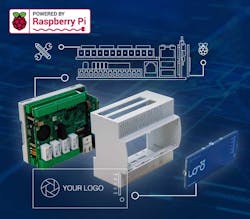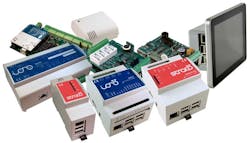11 Facts About Designing on Open Hardware
What you’ll learn:
- Eleven points to consider when designing on open hardware.
- How open embedded platforms, such as Raspberry Pi, can create an innovative industrial product design.
- Excellence in performance, reliability, long-term availability, and support is essential when designing products for industrial automation.
Just like with other technology fields, the pace of innovation in electronics is accelerating at unprecedented speed. A few decades ago, the force driving innovation in electronic hardware was the aerospace and defense industry. Other commercial sectors, like manufacturing and finance, followed. At the end of the tail were consumers, receiving only some of the benefits from those technological advances.
Today, in many cases, the direction of flow is entirely reversed. Consumer electronics is now a much more powerful and dynamic force, bursting all boundaries of innovation. The traditional innovators aren’t the primary intended recipients of these advances and instead use so-called commercial-off-the-shelf (COTS) technology for system development.
Launching a rocket into space and then, later, parts of it often returning safely for reuse multiple times is impressive engineering. Considering that lots of the hardware and software making that journey possible is running on the same computing architectures and operating system software running on an average smartphone, or actually on the smartphones of a few years ago, is even more impressive.
Industrial automation has always been the realm of very stable and time-proven solutions across technology, mainly when dealing with software and computing hardware. But industrial automation is changing, too, not only under the pressure of consumer-driven electronics innovation, but due to a shift in the cultural approach to electronics design that’s simply becoming more and more common.
None of these sorts of changes are new. We’ve seen this happening in the software industry, particularly in operating systems. Linux, for example, evolved from something strongly resisted in the “professional” information technology world to widespread acceptance and almost ubiquitous usage in most corporate IT infrastructures.
A similar trend in electronic hardware sparked up with Arduino over the last decade and then fired on all cylinders with the Raspberry Pi. With over 35 million boards sold to date, it would be pretty shortsighted to think of Raspberry Pi as a fun project for electronics enthusiasts, just as it was to consider Linux as nothing more than a software hack 20 years ago.
Today, there’s a vast community of people familiar with the Raspberry Pi and Arduino platforms, confident and motivated to bring them to work to address their needs, even for complex and demanding industrial automation applications. That doesn’t mean every other industrial automation platform is automatically obsolete. However, it’s safe to say that the trend points toward a growing adoption of these hardware platforms for industrial applications. To date, the industrial market for Raspberry Pi represents around 44% of total annual sales.
Although Raspberry Pi has gained much traction in many modern industrial applications, many challenges remain in designing industrial automation products. Rather than focusing on the advantages of using Raspberry Pi, this article discusses some of the main issues and explains how to address them.
1. Product Stability
Long-term availability is of paramount importance to any industrial automation product. The expected lifecycle of the typical industrial application is usually 10 years or more. It’s essential to have access to identical or at least fully compatible replacement parts throughout their lifetime.
Industrial automation products are often part of a larger design, and much effort goes into testing and certification of the whole system. Having to redo the process because one key component isn’t available is simply a nightmare scenario. This is usually considered the most critical weakness of industrial products that embed a Raspberry Pi or other open cores.
If properly managed, though, this could turn into a strength. Due to several factors, the electronic components supply chain is far from reliable these days. At the same time, most products are modular designs based on complex electronic parts that are unique, rather than discrete, generic components and may be subject to long-lasting shortages.
The Raspberry Pi has production volumes that are much larger than many dedicated industrial computing cores, which is the best guarantee for the long-term availability of these products. Raspberry Pi’s first version of its boards for embedded applications, the Compute Module 1, was introduced in early 2016. To date, it’s guaranteed to remain in production until at least January 2026, even though they are three generations ahead with the latest versions.
2. Design with Inherent Flexibility
To design an industrial product based on the Compute Module 1, the designer still must implement all of the surrounding interfaces and power-supply requirements. Cost considerations and other factors may drive the designer to engineer the product to properly fulfill the interfacing and power-supply requirements. After all, if the power supply requires 2 W, designing a power-supply stage delivering up to 6 W would turn into an extra cost with no return.
The new version of the Compute Module, however, is “almost” identical to the original, just 1 mm wider on one side but requiring twice as much power. When embedding these platforms and other complex modules, it’s critical to find the right balance between a tight, cost-optimized design and one with some flexibility. Inherent flexibility would allow the designer to accommodate some changes in the modules during integration without redesigning the whole product.
3. The Cost of Innovation
Open platforms tend to evolve faster than closed ones. Raspberry Pi released CM1, CM3, CM3+, and CM4 in the span of six years. When designing an industrial product based on an open platform, be prepared for the effort and cost of continuously evolving the product to keep up with the embedded platform.
Since long-term availability is a requirement, the new versions will go side by side with the older ones. Industrial customers demand both innovation and stability, and fulfilling these contrasting requirements is going to be expensive.
4. Resist Overdesign
This is closely related to the iterative innovation cycle of most open platforms, which usually add new features over time. For example, Wi-Fi connectivity may not be available initially, but it could come later in the design.
It may be tempting and sometimes feel forced to implement the missing features into the product. The risk here is to implement some features that differ and occasionally clash with the evolution of the core platform. Sometimes, it’s better to accept the platform’s current limitations rather than develop features already in development and with larger community support.
5. Test and Characterization Beyond Declared Specs
All electrical specifications were defined in the datasheets when designing electronic products based on discrete components or relatively simple integrated circuits. Components had few secrets. But when integrating complex modules, it’s pretty common to receive documentation with incomplete or missing information.
Some open platforms receive criticism because not all electrical or functional data are available. But this may also be the case with complex integrated circuits. With open platforms, some of the voids in the formal documentation are likely filled by the community.
In any case, be prepared to spend considerable engineering time testing the behavior of the modules beyond the declared specifications.
6. Compliance Testing
Compared to designs based on discrete components, integrating a complex module into the design may add complexity, if not significant issues, to the compliance testing or certification requirements. Some open platforms leave developers entirely on their own in this area, which may make it a much more expensive and time-consuming process.
However, that should not be considered a deterrent, just a factor to consider. Other platforms, and again Raspberry Pi is an example, have specific support programs in place to help designers, potentially saving a significant amount of time and costs.
7. The Copycats
When designing an industrial product with an embedded open platform, it makes it easier for others to create similar, if not identical, products. This is because a large portion of the complexity is concentrated in a module that’s readily available.
Still, one should resist the temptation to protect the product from copycats by shrouding the design in secrecy. Customers choose these types of products in the first place because they like the idea of openness, so be as open as possible. Here, continuous innovation, quality design, and full support are the best forms of defense against copycats.
8. Not Being Fully in Control of Your Fate
Much of a product’s success depends on the chosen platform. This might sound scary to a hardware engineer who is accustomed to being in control of everything, but it has always been the norm in software.
9. Choosing the Platforms
How to choose the right platform becomes the next obvious question. Probably the best answer is not to put all your eggs in the same basket. Ideally, designing different versions of the same product with the same feature set but using other embedded platforms could help reduce risk and significantly expand the addressable market.
10. Customer Support
When the first PCs came out with internal expansion slots, it was rather normal to be bounced off from customer support when they found out that a non-original board was installed. Today, technical support must be available for customers beyond your product, into the embedded platform and out to other topics. Customers who appreciate the idea of industrial products based on open platforms are used to having a lot of community support and widespread knowledge. You can’t fall behind their expectations.
11. Timing
If you like geometry, you might view all of the topics above as the axes in the multi-dimensional space of your engineering decisions. But, as in nature, there’s another dimension to consider—time. If you get everything else just right, but mess up with time, your project may be doomed.
Timing is everything, particularly when your design relies on community support of a platform you don’t control. You must be prudent not to embrace a platform too soon, even when it already shows clear signs of success. But at the same time, you can’t wait forever until that platform turns into a perfect ecosystem, as there’s no such thing.
Conclusion
Designing a product for the industrial automation market isn’t easy. Excellence in performance, reliability, long-term availability, and support is essential. Leveraging open embedded platforms in these designs is a new opportunity—a new tool in designers’ hands—where much value in terms of community support and knowledge can be instantaneously embedded into a new product.
As with all new trends, it may encounter some resistance. It’s also not necessarily the best solution in all cases. But this resistance is expected to weaken with support growth over time. Being fully aware of the challenges discussed should help you take advantage of the enormous opportunities that open platforms can bring to innovative industrial product design.
About the Author
Ulderico Arcidiaco
Co-Founder, CEO, and Lead Hardware Engineer, Sfera Labs
Ulderico Arcidiaco is an electronics engineer and in his spare time, airplane pilot, sailor, and amateur radio operator. He started his professional career at a leading multinational consulting company, designing integrated software architectures for mission-critical systems in industrial manufacturing and finance sectors. He then founded an engineering company to develop innovative internet-based software architectures. That company became the technology core of a fast-growing global digital media company, where Ulderico took the CTO's role, leading a multinational team of over 250 engineers.
Realizing the importance of systems integration in the home and building automation sector, he then co-founded a small, sharply focused company to develop a modern and flexible software platform for high-end building automation integration, where he still serves as CEO and CTO. Leveraging the experience in manufacturing automation, systems integration, and building management systems, but willing to also explore the potential of modern open-hardware design in industrial applications, Ulderico co-founded Sfera Labs in 2016, where he serves as CEO and lead hardware engineer.


